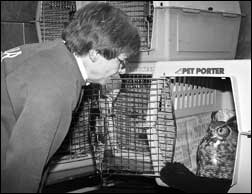Outbreak
of West Nile virus not as extensive as last year—
Fewer
sick birds at Raptor Center
While West Nile virus has hit local owls and hawks this
year, the damage to the raptor population has been considerably less than
last year, Raptor Center Director Betty Ross said last week.

Photo by Diane Chiddister
Raptor Center Director Betty Ross checks on a sick great horned
owl.
|
|
“It’s
definitely not as bad this year,” Ross said in an interview last
Friday. “A lot of the birds were wiped out last year and a lot of
them gained immunity.”
This year, according
to Ross, 17 owls and hawks with suspected West Nile virus have been brought
to the Raptor Center, which is part of the Glen Helen Ecology Institute.
The affected birds have come from across the Miami Valley, including Tipp
City, London, Wilmington, Troy, Springfield and New Carlisle.
“There’s
no hot pocket,” she said. “They’re coming from everywhere.”
This year’s
number is far fewer than last year’s, when 79 sick raptors, suspected
of having the virus, were brought to the center in August and September,
Ross said. Of the 79, only about 15 percent survived, she said.
Most of the sick
birds at the center this year have died, but a few seem to be recovering.
In Greene County,
29 birds were tested for West Nile virus, three of which tested positive,
according to Deborah Leopold of the Greene County Combined Health District.
Leopold said that the state stops testing after finding two positive results
in a county. The infected birds were a dove, a crow and a blue jay, Leopold
said.
Leopold said that
since June the health department has received about 110 calls regarding
ill or dead birds. Three Greene County horses have also tested positive
to date for the virus, and no other animals are believed to be infected.
There have been no
instances of the suspected virus in humans in Greene County, she said,
although a death in Montgomery County was recently linked to West Nile.
According to the
Ohio Department of Health’s Web site, 50 Ohioans have been infected
by the virus this year, and four have died from the disease. Last year
there were 299 probable cases and 31 deaths.
This year the first
birds that tested positive in Ohio were found in June, according to the
Web site, and 189 of 1,903 birds tested have tested positive, along with
657 mosquito pools. Statewide, 37 out of 227 horses have tested positive.
Infected birds tend
to look very immobile and are often found just sitting in a yard or field,
Ross said. Other symptoms include dilated eyes, drooping wings and bobbing
heads. The species most affected seem to be great horned owls, red-tailed
hawks and Cooper’s hawks, she said.
Ross encourages people
who find sick birds to bring them to the center, since without intervention,
they have no chance of survival. She also advises always using caution
when dealing with wild animals.
At the Raptor Center,
the birds are given supportive care, which includes rest, warmth and nutritional
supplements, Ross said. There are no antibiotics to address the virus,
she said.
After last year’s
epidemic of West Nile, the Raptor Center stocked up on syringes, tubes
and food to treat infected birds, and also vaccinated all of the center’s
birds, none of which, Ross said, have come down with the disease this
year.
This summer’s
rainy weather both helped and hindered the spread of West Nile, according
to Leopold, since the rain provided favorable breeding grounds for mosquitos
but may also have washed away the insects’ eggs.
Leopold urged Greene
County residents to protect themselves against the virus by wearing long-sleeved
clothing and insect repellent and by clearing property of standing water.
Birds, animals and humans can contract West Nile by being bitten by an
infected mosquito.
“People have
to realize that until we get a good frost, the insects are still out there,”
she said. “Especially at dusk, they’re very active.”
—Diane
Chiddister
|



